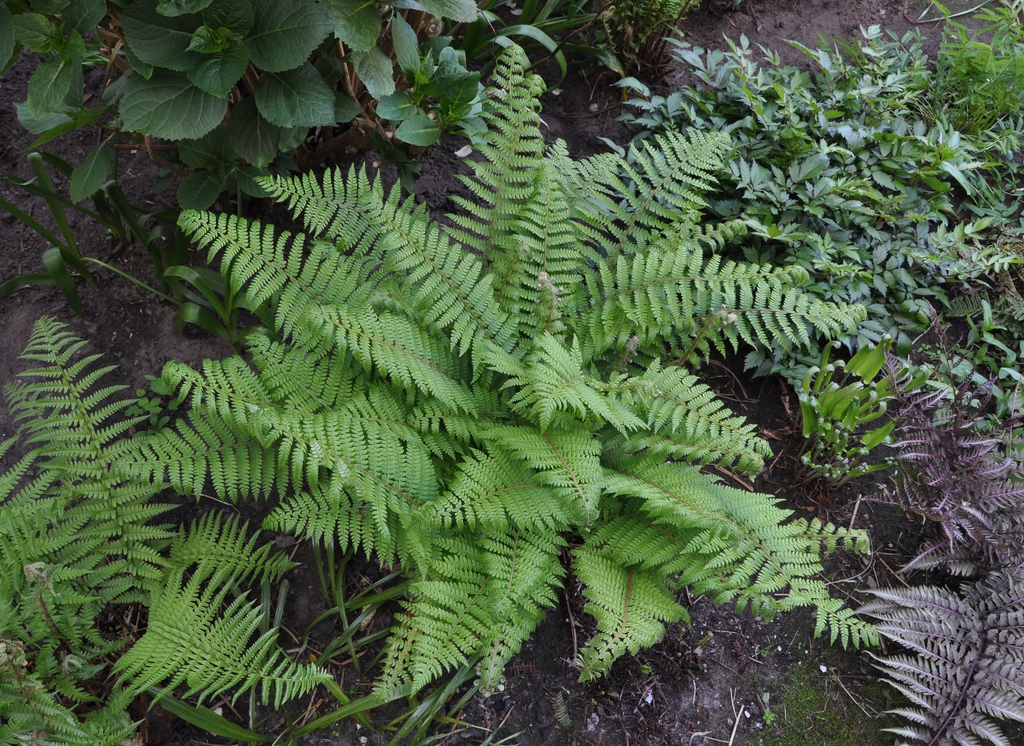Polystichum setiferum
Common Name(s):
- Phonetic Spelling
- pol-IS-tick-um seh-TIH-fer-um
- Description
-
The Hedge Fern or Soft Shield Ferns is a tufted evergreen in which its fronds curve outwards from the center of the plant, giving a whirlwind appearance when viewed from above.
It does best grown in part to full shade in fertile, moist, well-drained soil. Too much sun may cause the fronds yellow.
Cut down the fronds in February-March, before the new fronds emerge.
May remain evergreen in mild winter regions, otherwise semi-evergreen.
Most likely in the winter, crown rot may occur if the soil is not well-drained.
VIDEO Created by NC State Extension's Homegrown series featuring Mark Weathington, Director of JC Raulston Arboretum.
- Profile Video:
- See this plant in the following landscape:
- Cultivars / Varieties:
-
- 'Mossy Mama'
- 'Plumosum Densum'
- 'Mossy Mama'
- 'Mossy Mama', 'Plumosum Densum'
- Tags:


















- Cultivars / Varieties:
-
- 'Mossy Mama'
- 'Plumosum Densum'
- 'Mossy Mama'
- 'Mossy Mama', 'Plumosum Densum'
- Tags:
-
-
Attributes:
- Genus:
- Polystichum
- Species:
- setiferum
- Family:
- Polypodiaceae
- Life Cycle:
- Perennial
- Recommended Propagation Strategy:
- Division
- Country Or Region Of Origin:
- Macaronesia, Mediterranean to Iran
- Play Value:
- Easy to Grow
- Textural
- Particularly Resistant To (Insects/Diseases/Other Problems):
- Heavy shade, This plant is seldom damaged by deer.
- Dimensions:
- Height: 2 ft. 0 in. - 3 ft. 0 in.
- Width: 2 ft. 0 in. - 3 ft. 0 in.
-
-
Whole Plant Traits:
- Plant Type:
- Fern
- Herbaceous Perennial
- Habit/Form:
- Arching
- Clumping
- Mounding
- Growth Rate:
- Medium
- Maintenance:
- Medium
- Texture:
- Fine
-
-
Cultural Conditions:
- Light:
- Dappled Sunlight (Shade through upper canopy all day)
- Deep shade (Less than 2 hours to no direct sunlight)
- Partial Shade (Direct sunlight only part of the day, 2-6 hours)
- Soil Texture:
- Clay
- Loam (Silt)
- Sand
- Soil Drainage:
- Good Drainage
- Moist
- Available Space To Plant:
- 12 inches-3 feet
- NC Region:
- Coastal
- Piedmont
- USDA Plant Hardiness Zone:
- 7a, 7b, 8a, 8b, 9a
-
-
Fruit:
- Fruit Description:
- No fruits. This plants reproduces via spores.
-
-
Flowers:
- Flower Description:
- No flowers.
-
-
Leaves:
- Leaf Color:
- Green
- Leaf Feel:
- Soft
- Leaf Value To Gardener:
- Showy
- Leaf Type:
- Compound (Pinnately , Bipinnately, Palmately)
- Fronds
- Leaf Arrangement:
- Other/more complex
- Leaf Shape:
- Lanceolate
- Linear
- Rhomboidal
- Leaf Margin:
- Dentate
- Hairs Present:
- No
- Leaf Length:
- > 6 inches
- Leaf Description:
- Tufted, drooping fronds; mat, light green blade; scaly stalk; short-stemmed pinnulae; soft texture; twice divided pinnae have stalked linear-lanceolate pinnules with soft bristly tips on margins.
-
-
Stem:
- Stem Color:
- Brown/Copper
- Stem Is Aromatic:
- No
- Stem Description:
- Stalks are covered with cinnamon-brown scales.
-
-
Landscape:
- Landscape Location:
- Container
- Patio
- Rock Wall
- Woodland
- Landscape Theme:
- Cottage Garden
- Rock Garden
- Shade Garden
- Winter Garden
- Design Feature:
- Accent
- Border
- Mass Planting
- Small groups
- Resistance To Challenges:
- Deer
- Heavy Shade
- Rabbits







